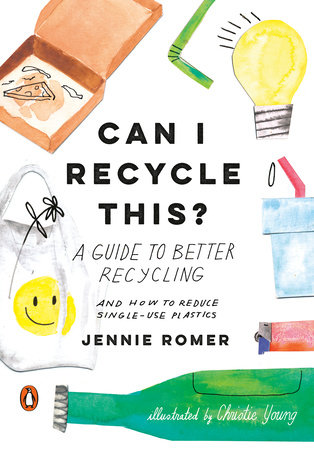
This deceptively simple question can lead to spirited discussions or disagreements with friends and family. The item in question may be accepted in one curbside program but not in an adjacent community. It could have been accepted in the past but is no longer accepted due to shifts in commodity market values. Many people are highly motivated to do something concrete to help the environment. They may even be willing to form new habits and incur some additional costs, but they are frustrated by seemingly inconsistent information available on the subject. Clarity is provided by Jennie Romer in her book, Can I Recycle This? – A Guide to Better Recycling and How to Reduce Single-Use Plastics (Penguin Books, 259 pages).
This coherently written and beautifully illustrated book provides both an educational overview and a handy reference. Knowledge gained advocating for reduced dependence on single-use plastics has given the author an edge in presenting complex issues in an understandable way. Attractive illustrations supplement the text, adding context for visual learners and providing structure to ideas and processes.
Just enough data is included to reveal how market prices drive the economic feasibility of recycling specific materials. “It only makes economic sense to recycle a material if the material sells for more than it would cost to landfill or incinerate this material. It’s all about the end markets,” writes Romer.
Glass is one example. In general, clear glass is more valuable than amber or green because it can be made into any color. But glass is heavy and thus costly to transport, and glass manufacturing plants are not evenly distributed around the country. Green is more valuable in California due to the winemaking industry, and amber is more valuable along the east coast and areas with more beer bottling operations.
Contamination due to “wishcycling” increases collection and processing costs, reducing the profitability of recyclable materials for which there is a market. Detailed answers to the “Can I Recycle This?” question are provided for over 60 different materials. This section also includes the best practices for preparing each material for the recycling bin.
Romer provides a personal solutions section highlighting individual actions that will improve the environment outside of the recycling system. These include avoiding single-use plastic bags, straws, and eating utensils, bringing your own food storage containers for leftovers, buying items in bulk, and wearing vintage clothing.
The book wraps up with a policy solutions section. The author explores strategies to increase demand for recycled content, enable the profitable collection and processing of recyclables, and improve diversion rates.
In reading this book, even experienced, knowledgeable, and enthusiastic recyclers will learn something new, enabling them to improve their habits and more effectively explain to others why they do the things they do.
Image courtesy of Penguin Random House
